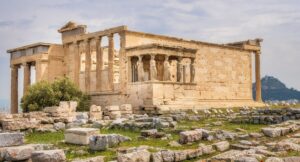Table of Contents
ToggleIntroduction
Standing at the entrance to the harbor of Rhodes, the Colossus of Rhodes was a colossal statue that captured the imagination of ancient travelers and continues to captivate us today. As one of the Seven Wonders of the Ancient World, this awe-inspiring monument symbolized the pride, resilience, and artistic achievements of the people of Rhodes. In this blog, we embark on a journey to explore the historical significance, construction, cultural impact, and eventual fate of the legendary Colossus of Rhodes.
The City of Rhodes: A Maritime Powerhouse
To understand the context of the Colossus, we delve into the rich history of Rhodes itself. We explore the island’s strategic location, its rise as a major maritime power, and the cultural and economic significance of the city.
The Origins of the Colossus
We explore the origins of the Colossus, including the motivations behind its construction and the cultural and religious symbolism associated with the statue. We delve into the legends and stories surrounding its creation, including the role of the renowned sculptor Chares of Lindos.
Construction and Engineering Marvel
The Colossus of Rhodes was an architectural and engineering marvel of the ancient world. We examine the techniques and materials used in its construction, the immense size and scale of the statue, and the innovative methods employed to support its weight.
Iconography and Symbolism
The Colossus served as a powerful symbol of victory and prestige for the people of Rhodes. We explore the iconography and symbolic meanings associated with the statue, including its representation of the sun god Helios, the protector and patron deity of the island.
Cultural and Economic Impact
The Colossus of Rhodes had a profound impact on the culture and economy of the city. We examine its influence on trade, tourism, and the city’s reputation as a center of art and culture. We also explore its role in fostering a sense of identity and unity among the people of Rhodes.
Destruction and Aftermath
Tragically, the Colossus of Rhodes stood for only a relatively short time before it was destroyed by an earthquake. We delve into the details of its demise, the efforts made to rebuild or preserve the statue, and its eventual fate as it lay in ruins.
Historical Accounts and Depictions
While no physical remnants of the Colossus exist today, we rely on historical accounts, artistic representations, and ancient descriptions to reconstruct its appearance and appreciate its grandeur. We explore the writings of ancient authors and examine various artistic depictions that offer glimpses into the splendor of the statue.
Legacy and Influence
Despite its relatively brief existence, the Colossus of Rhodes left an enduring legacy. We discuss its impact on subsequent art and sculpture, its place in popular culture and imagination, and its significance as a symbol of human creativity and ambition.
Modern Preservation and Remembrance
Although the Colossus no longer graces the harbor of Rhodes, efforts have been made to preserve its memory and commemorate its significance. We explore the various initiatives taken to honor the Colossus, including sculptures, replicas, and historical interpretations.
Rumors
The Colossus of Rhodes, being one of the ancient world’s most renowned wonders, has given rise to numerous rumors and speculations throughout history. Here are a few intriguing rumors associated with the Colossus:
- Straddling the Harbor: One persistent rumor suggests that the Colossus stood with its legs spread wide, straddling the entrance to the harbor of Rhodes. This popular depiction has been perpetuated by artistic interpretations and literature, despite lacking historical evidence. The notion of such a massive statue dominating the harbor adds a sense of grandeur and power to the legend of the Colossus.
- Reassembling the Colossus: According to a rumor that emerged in the Middle Ages, there were attempts to reassemble the fallen Colossus of Rhodes. Some accounts claim that a sultan, intrigued by the statue’s remnants, made an unsuccessful attempt to reconstruct it. While the story fuels the imagination, there is no concrete evidence to support the claim, and the logistics of such an undertaking would have been enormously challenging.
- Guardians of Hidden Treasure: Another intriguing rumor suggests that the Colossus of Rhodes served as a guardian of hidden treasures buried beneath it. Legends claim that the statue housed secret chambers or concealed treasures within its structure. This myth likely arose from the association of grand monuments with hidden riches and adds an element of mystery and adventure to the narrative surrounding the Colossus.
- Superhuman Proportions: Over time, exaggerated rumors have surfaced regarding the colossal size and superhuman proportions of the statue. Some accounts claim that the Colossus was so immense that ships could pass beneath its legs. These embellishments, although captivating, likely originated from imaginative retellings and artistic interpretations rather than historical accuracy.
It’s important to approach these rumors with caution, as they often stem from the blending of historical fact, myth, and imagination. While they contribute to the allure and mystique surrounding the Colossus of Rhodes, it is essential to rely on verified historical accounts and archaeological evidence to gain a more accurate understanding of the statue’s true nature and impact.
Conclusion
The Colossus of Rhodes, with its towering presence and cultural significance, remains an enduring symbol of ancient Greek artistry, engineering prowess, and the indomitable spirit of a city. Though lost to time, its legacy lives on, reminding us of the remarkable achievements of our ancestors and the ability of monumental works of art to transcend generations and inspire awe.



